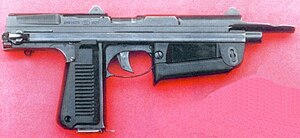PM-63
| PM-63 | |
|---|---|

|
|
| general information | |
| Country of operation: | Poland |
| Developer / Manufacturer: | Piotr Wilniewczyc |
| Manufacturer country: | VR Poland |
| Production time: | 1964 to 1977 |
| Weapon Category: | Submachine gun |
| Furnishing | |
| Overall length: | 583 (333 with folded shoulder rest) mm |
| Weight: (unloaded) | 1.6 kg |
| Barrel length : | 150 mm |
| Technical specifications | |
| Caliber : | 9 × 18 mm |
| Possible magazine fillings : | 15 or 25 cartridges |
| Ammunition supply : | Bar magazine |
| Cadence : | 650 rounds / min |
| Fire types: | Single, continuous fire |
| Number of trains : | 6th |
| Twist : | right |
| Visor : | open sights |
| Closure : | Mass closure |
| Charging principle: | Recoil loader |
| Lists on the subject | |
The PM-63 ( Polish : Pistolet maszynowy wzór 1963 , in German: Maschinenpistole Modell 1963 ) is an infantry weapon from Poland. Their deployment profile corresponds to that of a personal defense weapon . It is also referred to as RAK ( Ręczny Automat Komandosów , in German: Manual machine of the command forces ). It was developed under the name RAK WCB in 1960. The name was probably determined by the designer Piotr Wilniewczyc. He suggested the name in 1960 during a meeting. By this time Wilniewczyc was already seriously ill with cancer and died shortly afterwards. “Rak” means cancer in Polish .
technology
The PM-63 is a firing weapon with a hollow mass lock that partially encloses the barrel. The magazine slot is integrated in the handle, which enables very compact dimensions. The breech is on the outside like the slide of a self-loading pistol , with a flat part of the housing protruding far beyond the muzzle. This spur has two functions: on the one hand, it acts as a compensator to prevent the weapon from “climbing” in the event of bursts of fire, on the other hand it serves as an aid when loading. By pressing the spur of the weapon against a solid surface, the MPi can be cocked with just one hand.
The weapon is extremely light for a submachine gun. In order to be controllable at all, a compensator was essential. In addition, the cadence was reduced by a delay device. With maximum compression of the recoil spring , the slide is held while the retarder is pushed back a little further. A foldable handle at the front and a shoulder rest at the back allow two-handed use . Depending on the pressure on the trigger, the weapon fires single or continuous fire .
variants
In the 1970s, an export version in 9 × 19 mm was considered. However, only about 20 pre-production weapons were produced; nothing is known about an actual export.
During the Sino-Vietnamese war , Chinese soldiers captured Vietnamese raks. Subsequently, there was said to have been a Chinese counterfeit production (Type 82) in caliber 7.62 × 25 mm .
Users
-
 Poland : Polish Armed Forces (paratroopers, tank and artillery crews, border troops)
Poland : Polish Armed Forces (paratroopers, tank and artillery crews, border troops)
special units of the Polish police, Polish railway police -
 GDR : People's Police ( 9th People's Police Company )
GDR : People's Police ( 9th People's Police Company )
Guard Regiment "Feliks Dzierzynski" -
 Cuba
Cuba
-
 Vietnam : Vietnamese People's Army (tank crews)
Vietnam : Vietnamese People's Army (tank crews)
literature
- Günter Wollert, Reiner Lidschun, Wilfried Copenhagen : small arms . (1945-1985). In: Illustrated encyclopedia of rifles from around the world . 5th edition. tape 1 + 2 . Brandenburgisches Verlagshaus, Berlin 1988, ISBN 3-89488-057-0 , weapons, p. 350, 351 .
Individual evidence
- ^ A b c Günter Wollert, Reiner Lidschun, Wilfried Copenhagen: Rifle weapons . (1945-1985). In: Illustrated encyclopedia of rifles from around the world . 5th edition. tape 1 + 2 . Brandenburgisches Verlagshaus, Berlin 1988, ISBN 3-89488-057-0 , weapons, p. 350 .
- ↑ a b c d e f g h i Leszek Erenfeicht: PM-63 “Rak”. In: Forgotten Weapons. WordPress & Atahualpa, accessed on May 5, 2013 .
Web links
- Maxim Popenker: PM-63 Submachine gun (Poland). In: world.guns.ru. Retrieved September 8, 2017 .